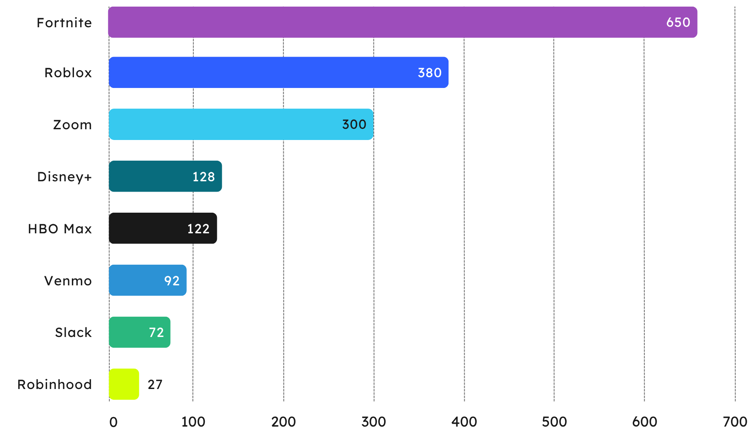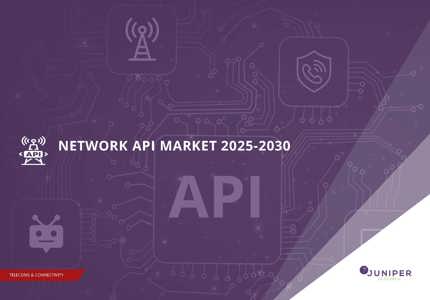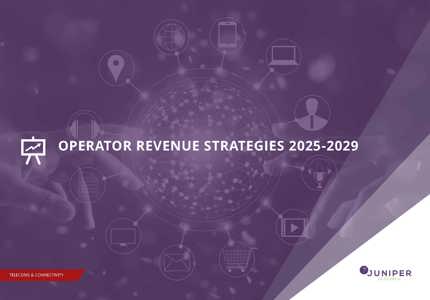AWS Outage: Are Enterprises Overestimating Cloud Reliability?
On October 20th, 2025, Amazon Web Services (AWS) experienced a substantial outage of its services in the US, with global impacts. The outage, caused by a domain name system (DNS) resolution failure that impacted a key database service, resulted in a cascading effect on AWS services. In turn, this led to many services that rely on AWS to also suffer outages; impacting consumers of various services including Disney+, Fortnite, HBO Max, Robinhood, Roblox, Slack, Venmo, and Zoom.
Estimated User Base for Select Service Providers Impacted by AWS Outage (m)

Source: Juniper Research
While AWS resolved the root cause of the issue within three hours, there were substantial impacts on various enterprises that leverage AWS. Despite the disruption, Amazon’s stock remained relatively stable; suggesting continued investor confidence in the company’s long-term market leadership. However, the incident could accelerate demand for multi-cloud orchestration tools, edge computing, and services that increase the overall resilience of cloud services. Overall, we expect the outage to initiate enterprises to explore new solutions or business models to increase the uptime of their services.
Is There an Overreliance on One Provider for Cloud Services?
The short answer is yes, we believe that there is an overreliance on many cloud services, notably AWS — which Juniper Research estimates to have a global market share of over 30%. As a company that has such a noteworthy presence in the market, it attracts the highest spending enterprises through significant degrees of redundancy within their operations to avoid scenarios like this. However, as is evident, no service is perfectly redundant, especially as the geographical reach of cloud services offered increases the complexity of network architectures. The larger the cloud service becomes, there is more within the service to fail, and a larger chance for cascading failures.
While AWS offers service credits for downtime, it does not cover the full operational and reputational costs. The event serves as a reminder that even leading cloud providers are not immune to large-scale disruptions.
Lessons are to be learned from this outage. Enterprises must not believe that services from AWS, and other leading providers such as Google and Microsoft, can be wholly relied upon, especially for enterprises that operate across multiple regions. The impacts of a failed DNS resolution must lead enterprises to explore multi-cloud strategies to increase redundancy and avoid vendor lock-in. Additionally, we recommend that enterprises implement their own monitoring software and not rely on the services provided by cloud providers.
The Financial Impact of AWS’s Outage
The financial impact of the outage is difficult to quantify at this stage, but we believe it will be significant. Many fintech services, such as Robinhood and Venmo, suffered downtime on their own platforms, which will likely lead to time spent on chargeback and dispute resolution, plus indirect costs of the outage. Similarly, digital platforms providers such as Disney+ and HBO Max suffered service interruptions; albeit for a small amount of downtime.
Aside from direct revenue loss from downtime, such as missed transactions and halted services, several indirect losses have resulted from this outage:
- Lost productivity for users of services such as Zoom or Slack. Many other enterprises rely on this for internal and external communication. This causes delays to AWS clients.
- Disrupted operations caused by the outage can also cause indirect costs through lost time. Key examples of this are enterprises in the healthcare or aviation industries that must be considered time-sensitive industries, where efficiency is key to maintaining profit; notably as profit margins can be small.
- Loss to brand reputation if services are down for substantial periods; leading to high levels of customer dissatisfaction. Essentially, this loss is unquantifiable, given the subjectivity and changes to opinion over time.
- Customer compensation, particularly in sectors like finance, travel, and telecoms, can add further costs through required refunds and service credits — as well as the unexpected time and resource needed to complete them.
How Must the Market Respond to this Outage?
It is reported that AWS’s service level agreements (SLAs) include 99.99% uptime for virtual servers, with discounts or credits to future services if AWS fails to meet these requirements. However, it's unlikely that these agreements cover lost enterprise revenue, productivity or reputational damage. Therefore, an enterprise’s choice of cloud service provider, or providers, must consider the impacts of this kind of outage. We believe that outages of any service are inevitable at some point.
Adopting a multi-cloud strategy will increase resilience and allow enterprises to mitigate the risks, direct costs, and indirect costs associated with these outages. A multi-cloud strategy will increase resilience and minimise the risk of extended periods of service downtime by enabling fallback onto a secondary service provider.
However, a key hurdle to enterprise adoption of multi-cloud strategies is the increased cost and complexity of implementation. For example, cloud service vendors will use a different suite of APIs, and security processes and functions are not interoperable between different platforms. Not only does this strategy lead to increased spend on cloud platforms, but additional training on the additional cloud service.
Outages such as this are a clear reminder that no service provider, regardless of reputation, scale or reach, can guarantee 100% uptime or provide complete protection against service downtime. While multi-vendor strategies will increase resilience, the high cost and interoperability challenges involved will likely exclude most cloud service users from adopting this strategy.
Indeed, we believe that cloud providers should embrace this challenge; providing solutions that are interoperable with other cloud platforms, including network APIs, to maximise the value of their solutions to enterprise users. After this outage, Juniper Research expects increased interest in a multi-cloud strategy, and platforms that can reduce spend and investment into integrating with additional systems will increase their value proposition to enterprises.
As VP of Telecoms Market Research at Juniper Research, Sam produces high-quality research on telecommunications technologies and the future of digital content. His recent reports include CPaaS, Direct-to-Cell, and 5G Future Strategies. Sam has been interviewed by leading media outlets, including the BBC and Wall Street Journal, and is a regular contributor to messaging conferences and telecommunications industry events.
Latest research, whitepapers & press releases
-
 ReportDecember 2025
ReportDecember 2025AI Agents for Customer Experience Platforms Market: 2025-2030
Our comprehensive AI Agents for Customer Experience Platforms research suite comprises detailed assessment of a market that is set to disrupt mobile communications. It provides stakeholders with insight into the key opportunities within the AI agents for customer experience platforms market over the next two years.
VIEW -
 ReportDecember 2025Fintech & Payments
ReportDecember 2025Fintech & PaymentseCommerce Fraud Prevention Market: 2025-2030
Our eCommerce Fraud Prevention research suite provides a detailed and insightful analysis of this evolving market; enabling stakeholders from financial institutions, law enforcement agencies, regulatory bodies and technology vendors to understand future growth, key trends, and the competitive environment.
VIEW -
 ReportNovember 2025Telecoms & Connectivity
ReportNovember 2025Telecoms & ConnectivityeSIMs & iSIMs Market: 2025-2030
Juniper Research’s eSIMs and iSIMs research suite offers insightful analysis of a market set to experience significant growth in the next five years. The research suite provides mobile network operators (MNOs), original equipment manufacturers (OEMs), and eSIM management and platforms vendors with intelligence on how to capitalise on the market growth, and guidance on how eSIM-only devices and sensors, SGP.42, in-factory provisioning, and iSIMs will change the competitive landscape.
VIEW -
 ReportNovember 2025Fintech & Payments
ReportNovember 2025Fintech & PaymentsModern Card Issuing Platforms Market: 2025-2030
Our Modern Card Issuing Platforms Market research suite provides a detailed and insightful analysis of this evolving market; enabling stakeholders from banks, financial institutions, fintech companies, and technology vendors to understand future growth, key trends, and the competitive environment.
VIEW -
 ReportNovember 2025Fintech & Payments
ReportNovember 2025Fintech & PaymentsDigital Wallets Market: 2025-2030
Our digital wallets research suite provides detailed analysis of this rapidly changing market; allowing digital wallet providers to gain an understanding of key payment trends and challenges, potential growth opportunities, and the competitive environment.
VIEW -
 ReportOctober 2025Fintech & Payments
ReportOctober 2025Fintech & PaymentsDigital Identity Market: 2025-2030
Juniper Research’s Digital Identity research suite provides a comprehensive and insightful analysis of this market; enabling stakeholders, including digital identity platform providers, digital identity verification providers, government agencies, banks, and many others, to understand future growth, key trends, and the competitive environment.
VIEW
-
 WhitepaperDecember 2025Telecoms & Connectivity
WhitepaperDecember 2025Telecoms & ConnectivityHuman + AI: Drivers of Customer Experience AI Agents in 2026
Our complimentary whitepaper, Human + AI: Drivers of Customer Experience AI Agents in 2026, examines the key drivers of the AI agents for customer experience platforms market in 2025.
VIEW -
 WhitepaperDecember 2025Fintech & Payments
WhitepaperDecember 2025Fintech & PaymentsBeyond Chargebacks: The True Cost of Fraud for Digital Commerce
Our complimentary whitepaper, Beyond Chargebacks: The True Cost of Fraud for Digital Commerce, examines the state of the eCommerce fraud prevention market; considering the impact of evolving digital fraud strategies, including key trends such as identity theft, account takeovers, chargebacks, policy abuse and friendly fraud.
VIEW -
 WhitepaperNovember 2025Telecoms & Connectivity
WhitepaperNovember 2025Telecoms & ConnectivityeSIM-only Devices: The Impact on Operators, Consumers, and IoT
Our complimentary whitepaper, eSIM-only Devices: The Impact on Operators, Consumers, and IoT, explores the challenges and opportunities for the three segments, with a particular focus on eSIM-only smartphones and SGP.42.
VIEW -
 WhitepaperNovember 2025Fintech & Payments
WhitepaperNovember 2025Fintech & PaymentsUnlocking the Next Stage of Growth for Modern Card Issuing Platforms
This free whitepaper analyses key trends shaping the modern card issuing space, and the ways in which modern card issuing platforms can capture growth.
VIEW -
 WhitepaperNovember 2025Fintech & Payments
WhitepaperNovember 2025Fintech & PaymentsTop 10 Fintech & Payments Trends 2026
Fintech is evolving fast. From stablecoins to agentic AI, our annual guide reveals the shifts redefining payments, digital identity, and the future of money in 2026. Download your copy today.
VIEW -
 WhitepaperNovember 2025Fintech & Payments
WhitepaperNovember 2025Fintech & PaymentsDigital Wallets: Empowering Financial Inclusivity
Our complimentary whitepaper, Digital Wallets: Empowering Financial Inclusivity, examines the state of the digital wallets market; considering the impact of digital wallets on different geographies, how they are shaping the modern payments landscape through lower transaction fees and promoting financial inclusivity for underbanked populations, and how they are competing with established payment methods.
VIEW
-
IoT & Emerging Technology
Juniper Research Unveils Top 10 Emerging Tech Trends to Watch in 2026
January 2026 -
Fintech & Payments
Digital Identity App Usage to Hit 6.2 Billion by 2030, Driven by Shift to Decentralised Models
December 2025 -
Telecoms & Connectivity
Travel eSIM Margins Under Pressure as Revenue per Gigabyte Falls 10% Globally in Two Years
December 2025 -
Telecoms & Connectivity
AI Agents to Power 1,000% More Customer Interactions for Enterprises Globally by 2027
December 2025 -
IoT & Emerging Technology
Global D2C Revenue Set for $370 Million Surge, But Satellite Operators Should Not Chase Full MNO Status
December 2025 -
Fintech & Payments
Digital Goods Fraud to Cost eCommerce Merchants $27 Billion Globally by 2030 as AI Tools Accelerate Attacks
December 2025
























